Identification and Prediction Methods for Frontier Interdisciplinary Fields Integrating Large Language Models
Abstract
1. Introduction
- (1)
- Methodological Innovation: We propose an integrated framework that combines semantic classification via ChatGPT-3.5-Turbo, novel interdisciplinarity and frontierness metrics, and time series forecasting. This overcomes the limitations of traditional citation-based or keyword-based approaches and enhances the precision and scalability of frontier field identification.
- (2)
- Metric System for Interdisciplinarity and Frontierness: A set of indicators is introduced to quantify the degree and depth of disciplinary integration, as well as the novelty, growth, and impact of a field. These metrics provide a systematic basis for identifying and comparing interdisciplinary dynamics across domains.
- (3)
- Time Series Forecasting for Frontier Trend Analysis: We evaluate and compare linear, machine learning, and deep learning models for predicting research field trajectories. The Transformer model is found to perform best, offering a robust, data-driven tool for prospective trend analysis in science and technology studies.
- (4)
- Empirical Validation: Using synthetic biology as a case study, the framework demonstrates its practical effectiveness in capturing the interdisciplinary structure, research frontierness, and developmental trajectory of an emerging field.
2. Literature Review
2.1. Research Front Identification
2.2. Interdisciplinary Research Identification
2.3. Time Series Modeling in Interdisciplinary Frontier Identification
2.4. Limitations of Existing Research
- (1)
- Methodological Fragmentation:
- (2)
- Narrow Scope of Interdisciplinary Focus:
- (3)
- Static Analysis and Forecasting Gaps:
- (4)
- Semantic and Temporal Limitations:
3. Research Framework
3.1. Interdisciplinarity Identification Method
3.1.1. Paper Classification System Based on ChatGPT
- (1)
- Precision: indicates the proportion of papers that were classified into a certain category by the model and indeed belong to that category. It is calculated as follows:
- (2)
- Recall: indicates the proportion of papers that actually belong to a certain category and were successfully identified by the model. It is calculated as follows:
- (3)
- F1 score: the harmonic mean of precision and recall, used to comprehensively assess the model’s accuracy and coverage. It is calculated as follows:
3.1.2. Indicators for Disciplinary Interdisciplinarity Degree and Disciplinary Integration Strength
3.1.3. Temporal Indicators of Interdisciplinary Integration Strength
3.2. Frontierness Identification of Research Fields
3.2.1. Novelty Indicator
3.2.2. Growth Indicator
3.2.3. Impact Indicator
3.3. Field Trend Analysis Methods
3.3.1. Time Series Models
3.3.2. Evaluation Metrics for Time Series Models
3.4. Identification of Frontier Interdisciplinary Fields
4. Empirical Analysis
4.1. Data Source
4.2. Interdisciplinarity Identification
4.2.1. Disciplinary Classification and Interdisciplinary Scale Analysis
4.2.2. Analysis of Interdisciplinary Integration Strength
4.2.3. Overall Network Analysis of Interdisciplinary Connections
4.2.4. Evolutionary Analysis of the Interdisciplinary Network
4.3. Frontierness Analysis of the Field
4.3.1. Novelty
4.3.2. Growth
4.3.3. Impact
4.3.4. Field Potential
4.4. Trend Analysis of the Field
4.4.1. Model Construction and Error Evaluation
4.4.2. Model Comparison and Best Model Selection
4.5. Identification of Frontier Interdisciplinary Domain
4.5.1. Interdisciplinarity and Frontierness
4.5.2. Trend Outlook and Strategic Role
4.5.3. Final Positioning
5. Discussion
5.1. Effectiveness of the Methodological Framework and Forecasting Algorithms
5.2. Interdisciplinary Integration and Frontier Characteristics of Synthetic Biology
5.3. Development Trends and Future Growth Forecast
5.4. Challenges, Limitations, and Future Directions
6. Conclusions
Supplementary Materials
Author Contributions
Funding
Data Availability Statement
Acknowledgments
Conflicts of Interest
References
- Klein, J.T. Beyond Interdisciplinarity: Boundary Work, Communication, and Collaboration; Oxford University Press: Oxford, UK, 2021. [Google Scholar]
- Zahra, S.A.; Newey, L.R. Maximizing the impact of organization science: Theory-building at the intersection of disciplines and/or fields. J. Manag. Stud. 2009, 46, 1059–1075. [Google Scholar] [CrossRef]
- Keohane, R.O.; Victor, D.G. The regime complex for climate change. Perspect. Politics 2011, 9, 7–23. [Google Scholar] [CrossRef]
- Newell, P. Globalization and the governance of biotechnology. Glob. Environ. Politics 2003, 3, 56–71. [Google Scholar] [CrossRef]
- Dwivedi, Y.K.; Hughes, L.; Kar, A.K.; Baabdullah, A.M.; Grover, P.; Abbas, R.; Andreini, D.; Abumoghli, I.; Barlette, Y.; Bunker, D. Climate change and COP26: Are digital technologies and information management part of the problem or the solution? An editorial reflection and call to action. Int. J. Inf. Manag. 2022, 63, 102456. [Google Scholar] [CrossRef]
- Le, T.; Pham, H.; Mai, S.; Vu, N. Frontier academic research, industrial R&D and technological progress: The case of OECD countries. Technovation 2022, 114, 102436. [Google Scholar] [CrossRef]
- Ye, G.; Wang, C.; Wu, C.; Peng, Z.; Wei, J.; Song, X.; Tan, Q.; Wu, L. Research frontier detection and analysis based on research grants information: A case study on health informatics in the US. J. Informetr. 2023, 17, 101421. [Google Scholar] [CrossRef]
- Huang, M.-H.; Chang, C.-P. Detecting research fronts in OLED field using bibliographic coupling with sliding window. Scientometrics 2014, 98, 1721–1744. [Google Scholar] [CrossRef]
- Morss, R.E.; Lazrus, H.; Demuth, J.L. The “inter” within interdisciplinary research: Strategies for building integration across fields. Risk Anal. 2021, 41, 1152–1161. [Google Scholar] [CrossRef]
- Newman, J. Promoting interdisciplinary research collaboration: A systematic review, a critical literature review, and a pathway forward. Soc. Epistemol. 2024, 38, 135–151. [Google Scholar] [CrossRef]
- Yu, M.; Li, J.; Cui, Y. Review on Science and Technology Trend Awareness Research. In Proceedings of the 2024 3rd International Conference on Big Data, Information and Computer Network (BDICN), Sanya, China, 12–14 January 2024; pp. 1–6. [Google Scholar]
- Ozsoy, C.M.; Mengüç, M.P. A transdisciplinary approach and design thinking methodology: For applications to complex problems and energy transition. World 2024, 5, 119–135. [Google Scholar] [CrossRef]
- Li, T.; Cui, L.; Lv, W.; Song, X.; Cui, X.; Tang, L. Exploring the frontiers of sustainable livelihoods research within grassland ecosystem: A scientometric analysis. Heliyon 2022, 8, e10704. [Google Scholar] [CrossRef] [PubMed]
- Amado, A.; Cortez, P.; Rita, P.; Moro, S. Research trends on Big Data in Marketing: A text mining and topic modeling based literature analysis. Eur. Res. Manag. Bus. Econ. 2018, 24, 1–7. [Google Scholar] [CrossRef]
- Funk, P.; Davis, A.; Vaishnav, P.; Dewitt, B.; Fuchs, E. Individual inconsistency and aggregate rationality: Overcoming inconsistencies in expert judgment at the technical frontier. Technol. Forecast. Soc. Change 2020, 155, 119984. [Google Scholar] [CrossRef]
- Azoulay, P.; Lynn, F.B. Self-citation, cumulative advantage, and gender inequality in science. Sociol. Sci. 2020, 7, 152–186. [Google Scholar] [CrossRef]
- Hall, B.H.; Jaffe, A.B.; Trajtenberg, M. The NBER Patent Citation Data File: Lessons, Insights and Methodological Tools; National Bureau of Economic Research: Cambridge, MA, USA, 2001. [Google Scholar]
- Gerlach, M.; Peixoto, T.P.; Altmann, E.G. A network approach to topic models. Sci. Adv. 2018, 4, eaaq1360. [Google Scholar] [CrossRef]
- Więckowski, J.; Kizielewicz, B.; Wątróbski, J.; Sałabun, W. A New Approach for Handling Uncertainty of Expert Judgments in Complex Decision Problems. IEEE Access 2024, 12, 142026–142046. [Google Scholar] [CrossRef]
- Lesnikowski, A.; Belfer, E.; Rodman, E.; Smith, J.; Biesbroek, R.; Wilkerson, J.D.; Ford, J.D.; Berrang-Ford, L. Frontiers in data analytics for adaptation research: Topic modeling. Wiley Interdiscip. Rev. Clim. Change 2019, 10, e576. [Google Scholar] [CrossRef]
- Wang, X.; Zhang, S.; Liu, Y. ITGInsight–discovering and visualizing research fronts in the scientific literature. Scientometrics 2022, 127, 6509–6531. [Google Scholar] [CrossRef]
- Wang, X.; Zhang, S.; Liu, Y.; Du, J.; Huang, H. How pharmaceutical innovation evolves: The path from science to technological development to marketable drugs. Technol. Forecast. Soc. Change 2021, 167, 120698. [Google Scholar] [CrossRef]
- Yu, D.; Yan, Z. Combining machine learning and main path analysis to identify research front: From the perspective of science-technology linkage. Scientometrics 2022, 127, 4251–4274. [Google Scholar] [CrossRef]
- Price de Solla, D.J. Networks of scientific papers. Science 1965, 149, 510–515. [Google Scholar] [CrossRef]
- Small, H.; Griffith, B.C. The structure of scientific literatures I: Identifying and graphing specialties. Sci. Stud. 1974, 4, 17–40. [Google Scholar] [CrossRef]
- Shibata, N.; Kajikawa, Y.; Takeda, Y.; Matsushima, K. Comparative study on methods of detecting research fronts using different types of citation. J. Am. Soc. Inf. Sci. Technol. 2009, 60, 571–580. [Google Scholar] [CrossRef]
- Williamson, K. Chapter 12—The Delphi method. In Research Methods for Students, Academics and Professionals, 2nd ed.; Williamson, K., Bow, A., Burstein, F., Darke, P., Harvey, R., Johanson, G., McKemmish, S., Oosthuizen, M., Saule, S., Schauder, D., et al., Eds.; Chandos Publishing: Oxfordshire, UK, 2002; pp. 209–220. [Google Scholar] [CrossRef]
- Osareh, F. Bibliometrics, citation analysis and co-citation analysis: A review of literature I. Libri 1996, 46, 217–225. [Google Scholar] [CrossRef]
- Weinberg, B.H. Bibliographic coupling: A review. Inf. Storage Retr. 1974, 10, 189–196. [Google Scholar] [CrossRef]
- Zhang, T.; Chen, J.; Lu, Y.; Yang, X.; Ouyang, Z. Identification of technology frontiers of artificial intelligence-assisted pathology based on patent citation network. PLoS ONE 2022, 17, e0273355. [Google Scholar] [CrossRef] [PubMed]
- Xu, D.; Liu, B.; Wang, J.; Zhang, Z. Bibliometric analysis of artificial intelligence for biotechnology and applied microbiology: Exploring research hotspots and frontiers. Front. Bioeng. Biotechnol. 2022, 10, 998298. [Google Scholar] [CrossRef]
- Chen, X.; Mao, J.; Li, G. A co-citation approach to the analysis on the interaction between scientific and technological knowledge. J. Informetr. 2024, 18, 101548. [Google Scholar] [CrossRef]
- Ma, C.; Xu, Q.; Li, B. Comparative study on intelligent education research among countries based on bibliographic coupling analysis. Libr. Hi Tech 2022, 40, 786–804. [Google Scholar] [CrossRef]
- Yanhui, S.; Lijuan, W.; Junping, Q. A comparative study of first and all-author bibliographic coupling analysis based on Scientometrics. Scientometrics 2021, 126, 1125–1147. [Google Scholar] [CrossRef]
- Liu, J.S.; Lu, L.Y.; Lu, W.-M. Research fronts in data envelopment analysis. Omega 2016, 58, 33–45. [Google Scholar] [CrossRef]
- Wei, Y.-M.; Wang, J.-W.; Chen, T.; Yu, B.-Y.; Liao, H. Frontiers of low-carbon technologies: Results from bibliographic coupling with sliding window. J. Clean. Prod. 2018, 190, 422–431. [Google Scholar] [CrossRef]
- Kleinberg, J. Bursty and hierarchical structure in streams, data mining and knowledge discovery. In Proceedings of the Elected Papers from the 8th ACM SIGKDD International Conference on Knowledge I Discovery and Data Mining? Edmonton, AB, Canada, 23–26 July 2002; pp. 372–397. [Google Scholar]
- Li, M.; Chu, Y. Explore the research front of a specific research theme based on a novel technique of enhanced co-word analysis. J. Inf. Sci. 2017, 43, 725–741. [Google Scholar] [CrossRef]
- Xie, T.; Qin, P.; Yan, J. Research on Artificial Intelligence Frontier Recognition Based on LDA. Open Access Libr. J. 2018, 5, 1–13. [Google Scholar] [CrossRef]
- Wu, Q.; Kuang, Y.; Hong, Q.; She, Y. Frontier knowledge discovery and visualization in cancer field based on KOS and LDA. Scientometrics 2019, 118, 979–1010. [Google Scholar] [CrossRef]
- Yu, D.; Xiang, B. Discovering topics and trends in the field of Artificial Intelligence: Using LDA topic modeling. Expert Syst. Appl. 2023, 225, 120114. [Google Scholar] [CrossRef]
- Liu, Y.; Wan, F. Unveiling temporal and spatial research trends in precision agriculture: A BERTopic text mining approach. Heliyon 2024, 10, e36808. [Google Scholar] [CrossRef]
- He, J.; Chen, C. Predictive effects of novelty measured by temporal embeddings on the growth of scientific literature. Front. Res. Metr. Anal. 2018, 3, 9. [Google Scholar] [CrossRef]
- Park, I.; Yoon, B. Identifying promising research frontiers of pattern recognition through bibliometric analysis. Sustainability 2018, 10, 4055. [Google Scholar] [CrossRef]
- Wang, Z.; Chen, J.; Chen, J.; Chen, H. Identifying interdisciplinary topics and their evolution based on BERTopic. Scientometrics 2024, 129, 7359–7384. [Google Scholar] [CrossRef]
- Xu, J.; Bu, Y.; Ding, Y.; Yang, S.; Zhang, H.; Yu, C.; Sun, L. Understanding the formation of interdisciplinary research from the perspective of keyword evolution: A case study on joint attention. Scientometrics 2018, 117, 973–995. [Google Scholar] [CrossRef]
- Wang, L.; Notten, A.; Surpatean, A. Interdisciplinarity of nano research fields: A keyword mining approach. Scientometrics 2013, 94, 877–892. [Google Scholar] [CrossRef]
- Xu, H.; Guo, T.; Yue, Z.; Ru, L.; Fang, S. Interdisciplinary topics of information science: A study based on the terms interdisciplinarity index series. Scientometrics 2016, 106, 583–601. [Google Scholar] [CrossRef]
- Kim, K.; Kogler, D.F.; Maliphol, S. Identifying interdisciplinary emergence in the science of science: Combination of network analysis and BERTopic. Humanit. Soc. Sci. Commun. 2024, 11, 603. [Google Scholar] [CrossRef]
- Wang, M.; Xie, Y.; Guo, X.; Fu, H. Interdisciplinarity in the Built Environment: Measurement and Interdisciplinary Topic Identification. Buildings 2024, 14, 3718. [Google Scholar] [CrossRef]
- Chaoguang, H.; Yueji, H.; Fanfan, H.; Chenwei, Z. An approach for interdisciplinary knowledge discovery: Link prediction between topics. Phys. A Stat. Mech. Its Appl. 2025, 665, 130517. [Google Scholar] [CrossRef]
- Omodei, E.; De Domenico, M.; Arenas, A. Evaluating the impact of interdisciplinary research: A multilayer network approach. Netw. Sci. 2017, 5, 235–246. [Google Scholar] [CrossRef]
- Adams, J.; Light, R. Mapping interdisciplinary fields: Efficiencies, gaps and redundancies in HIV/AIDS research. PLoS ONE 2014, 9, e115092. [Google Scholar] [CrossRef]
- Montgomery, D.C.; Jennings, C.L.; Kulahci, M. Introduction to Time Series Analysis and Forecasting; John Wiley & Sons: Hoboken, NJ, USA, 2015. [Google Scholar]
- Liu, Z.; Zhu, Z.; Gao, J.; Xu, C. Forecast methods for time series data: A survey. IEEE Access 2021, 9, 91896–91912. [Google Scholar] [CrossRef]
- Mudelsee, M. Trend analysis of climate time series: A review of methods. Earth-Sci. Rev. 2019, 190, 310–322. [Google Scholar] [CrossRef]
- Abuhay, T.M.; Nigatie, Y.G.; Kovalchuk, S.V. Towards predicting trend of scientific research topics using topic modeling. Procedia Comput. Sci. 2018, 136, 304–310. [Google Scholar] [CrossRef]
- Xiong, X.; Yang, G.-L.; Zhou, D.-Q.; Wang, Z.-L. How to allocate multi-period research resources? Centralized resource allocation for public universities in China using a parallel DEA-based approach. Socio-Econ. Plan. Sci. 2022, 82, 101317. [Google Scholar] [CrossRef]
- Li, X.; Liu, Y.; Li, A.; Yang, X.; Tang, X. Research on the Subject Mapping Methods Optimization of Multi-Sources Biomedical Literatures. Digit. Libr. Forum 2023, 19, 1–9. [Google Scholar]
- Biglan, A. The characteristics of subject matter in different academic areas. J. Appl. Psychol. 1973, 57, 195–203. [Google Scholar] [CrossRef]
- Ma, L.; Zhao, Y.; Zuo, K.; Yi, P.; Liu, H. Analysis on the development trends of synthetic biology from the interdisciplinary perspective. Sci. Manag. Res. 2023, 41, 19–26. [Google Scholar] [CrossRef]
- Leydesdorff, L. On the normalization and visualization of author co-citation data: Salton’s Cosine versus the Jaccard index. J. Am. Soc. Inf. Sci. Technol. 2008, 59, 77–85. [Google Scholar] [CrossRef]
- Gribetz, S.K.; Kaye, L. 3 Time in Disciplinary and Interdisciplinary Perspective. In Time: A Multidisciplinary Introduction; Walter de Gruyter GmbH: Berlin, Germany, 2023; pp. 53–82. [Google Scholar]
- Frogeri, R.F.; Júnior, P.d.S.P. Interdisciplinary Frontiers: Bridging Knowledge for Contemporary Challenges. Rev. Myth. 2025, 22, 238–243. [Google Scholar] [CrossRef]
- Dalal, A.-A.; AlRassas, A.M.; Al-qaness, M.A.; Cai, Z.; Aseeri, A.O.; Abd Elaziz, M.; Ewees, A.A. TLIA: Time-series forecasting model using long short-term memory integrated with artificial neural networks for volatile energy markets. Appl. Energy 2023, 343, 121230. [Google Scholar]
- Gers, F.A.; Schmidhuber, J.; Cummins, F. Learning to forget: Continual prediction with LSTM. Neural Comput. 2000, 12, 2451–2471. [Google Scholar] [CrossRef]
- Dey, R.; Salem, F.M. Gate-variants of gated recurrent unit (GRU) neural networks. In Proceedings of the 2017 IEEE 60th International Midwest Symposium on Circuits and Systems (MWSCAS), Boston, MA, USA, 6–9 August 2017; pp. 1597–1600. [Google Scholar]
- Vaswani, A.; Shazeer, N.; Parmar, N.; Uszkoreit, J.; Jones, L.; Gomez, A.N.; Kaiser, Ł.; Polosukhin, I. Attention is all you need. In Advances in Neural Information Processing Systems; The MIT Press: Cambridge, MA, USA, 2017; p. 30. [Google Scholar]
- Breiman, L. Random forests. Mach. Learn. 2001, 45, 5–32. [Google Scholar] [CrossRef]
- Montgomery, D.C.; Peck, E.A.; Vining, G.G. Introduction to Linear Regression Analysis; John Wiley & Sons: Hoboken, NJ, USA, 2021. [Google Scholar]
- Yuan, Y.; Meng, Y. Evolutionary Analysis and Frontier Identification of Interdisciplinary Research in Foreign LIS Field Based on BERT-LDA. Digit. Libr. Forum 2024, 20, 1–15. [Google Scholar]
- Dwivedi, Y.K.; Sharma, A.; Rana, N.P.; Giannakis, M.; Goel, P.; Dutot, V. Evolution of artificial intelligence research in Technological Forecasting and Social Change: Research topics, trends, and future directions. Technol. Forecast. Soc. Change 2023, 192, 122579. [Google Scholar] [CrossRef]
- Hain, D.; Jurowetzki, R.; Lee, S.; Zhou, Y. Machine learning and artificial intelligence for science, technology, innovation mapping and forecasting: Review, synthesis, and applications. Scientometrics 2023, 128, 1465–1472. [Google Scholar] [CrossRef]
- Iram, A.; Dong, Y.; Ignea, C. Synthetic biology advances towards a bio-based society in the era of artificial intelligence. Curr. Opin. Biotechnol. 2024, 87, 103143. [Google Scholar] [CrossRef]
- Gong, X.; Zhang, J.; Gan, Q.; Teng, Y.; Hou, J.; Lyu, Y.; Liu, Z.; Wu, Z.; Dai, R.; Zou, Y. Advancing microbial production through artificial intelligence-aided biology. Biotechnol. Adv. 2024, 74, 108399. [Google Scholar] [CrossRef]
- Silva, T.C.; Eppink, M.; Ottens, M. Automation and miniaturization: Enabling tools for fast, high-throughput process development in integrated continuous biomanufacturing. J. Chem. Technol. Biotechnol. 2022, 97, 2365–2375. [Google Scholar] [CrossRef]
- Jiang, W.; Wu, Z.; Gao, Z.; Wan, M.; Zhou, M.; Mao, C.; Shen, J. Artificial cells: Past, present and future. ACS Nano 2022, 16, 15705–15733. [Google Scholar] [CrossRef]
- Dixit, S.; Kumar, A.; Srinivasan, K.; Vincent, P.D.R.; Ramu Krishnan, N. Advancing genome editing with artificial intelligence: Opportunities, challenges, and future directions. Front. Bioeng. Biotechnol. 2024, 11, 1335901. [Google Scholar] [CrossRef]
- Li, Z.; Khan, W.U.; Bai, G.; Dong, C.; Wang, J.; Zhang, Y.; Wang, C.; Zhang, H.; Wang, W.; Luo, M.; et al. From Code to Life: The AI-Driven Revolution in Genome Editing. Adv. Sci. 2025, e17029. [Google Scholar] [CrossRef]
- Chen, V.; Yang, M.; Cui, W.; Kim, J.S.; Talwalkar, A.; Ma, J. Applying interpretable machine learning in computational biology—Pitfalls, recommendations and opportunities for new developments. Nat. Methods 2024, 21, 1454–1461. [Google Scholar] [CrossRef]
- Xue, L.; Pang, Z. Ethical governance of artificial intelligence: An integrated analytical framework. J. Digit. Econ. 2022, 1, 44–52. [Google Scholar] [CrossRef]
- Mateos Fernández, R.; Petek, M.; Gerasymenko, I.; Juteršek, M.; Baebler, Š.; Kallam, K.; Moreno Giménez, E.; Gondolf, J.; Nordmann, A.; Gruden, K. Insect pest management in the age of synthetic biology. Plant Biotechnol. J. 2022, 20, 25–36. [Google Scholar] [CrossRef]
- Li, J.; Zhao, H.; Zheng, L.; An, W. Advances in synthetic biology and biosafety governance. Front. Bioeng. Biotechnol. 2021, 9, 598087. [Google Scholar] [CrossRef] [PubMed]
- Sun, T.; Song, J.; Wang, M.; Zhao, C.; Zhang, W. Challenges and recent progress in the governance of biosecurity risks in the era of synthetic biology. J. Biosaf. Biosecur. 2022, 4, 59–67. [Google Scholar] [CrossRef]
- Liao, C.; Xiao, S.; Wang, X. Bench-to-bedside: Translational development landscape of biotechnology in healthcare. Health Sci. Rev. 2023, 7, 100097. [Google Scholar] [CrossRef]
- Brooks, S.M.; Alper, H.S. Applications, challenges, and needs for employing synthetic biology beyond the lab. Nat. Commun. 2021, 12, 1390. [Google Scholar] [CrossRef] [PubMed]
- Hanna, E.; Levic, A. Comparative Analysis of Language Models: Hallucinations in ChatGPT: Prompt Study. 2023. Available online: https://www.diva-portal.org/smash/record.jsf?pid=diva2%3A1764165&dswid=2283 (accessed on 10 May 2025).
- Herrera-Poyatos, D.; Zuheros, C.; Montes, R.; Herrera, F. Large language models for crowd decision making based on prompt design strategies using ChatGPT: Models, analysis and challenges. arXiv 2024, arXiv:2403.15587. [Google Scholar]
- Kalai, A.T.; Vempala, S.S. Calibrated language models must hallucinate. In Proceedings of the 56th Annual ACM Symposium on Theory of Computing, Vancouver, BC, Canada, June 24–28 2024; pp. 160–171. [Google Scholar]
- Evstafev, E. The Paradox of Stochasticity: Limited Creativity and Computational Decoupling in Temperature-Varied LLM Outputs of Structured Fictional Data. arXiv 2025, arXiv:2502.08515. [Google Scholar]
- Yu, G.; Guo, R.; Li, Y.-J. The influence of publication delays on three ISI indicators. Scientometrics 2006, 69, 511–527. [Google Scholar] [CrossRef]
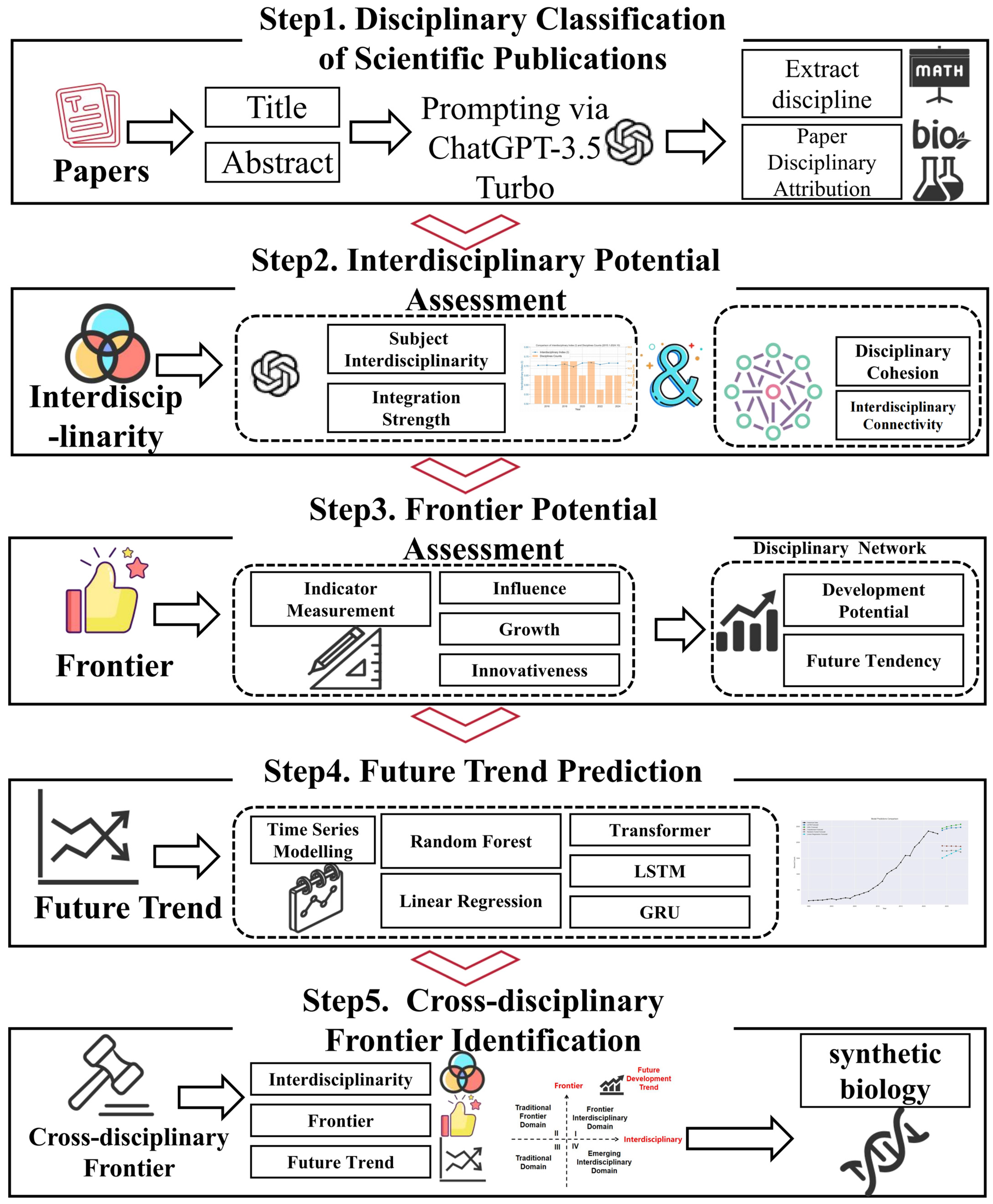
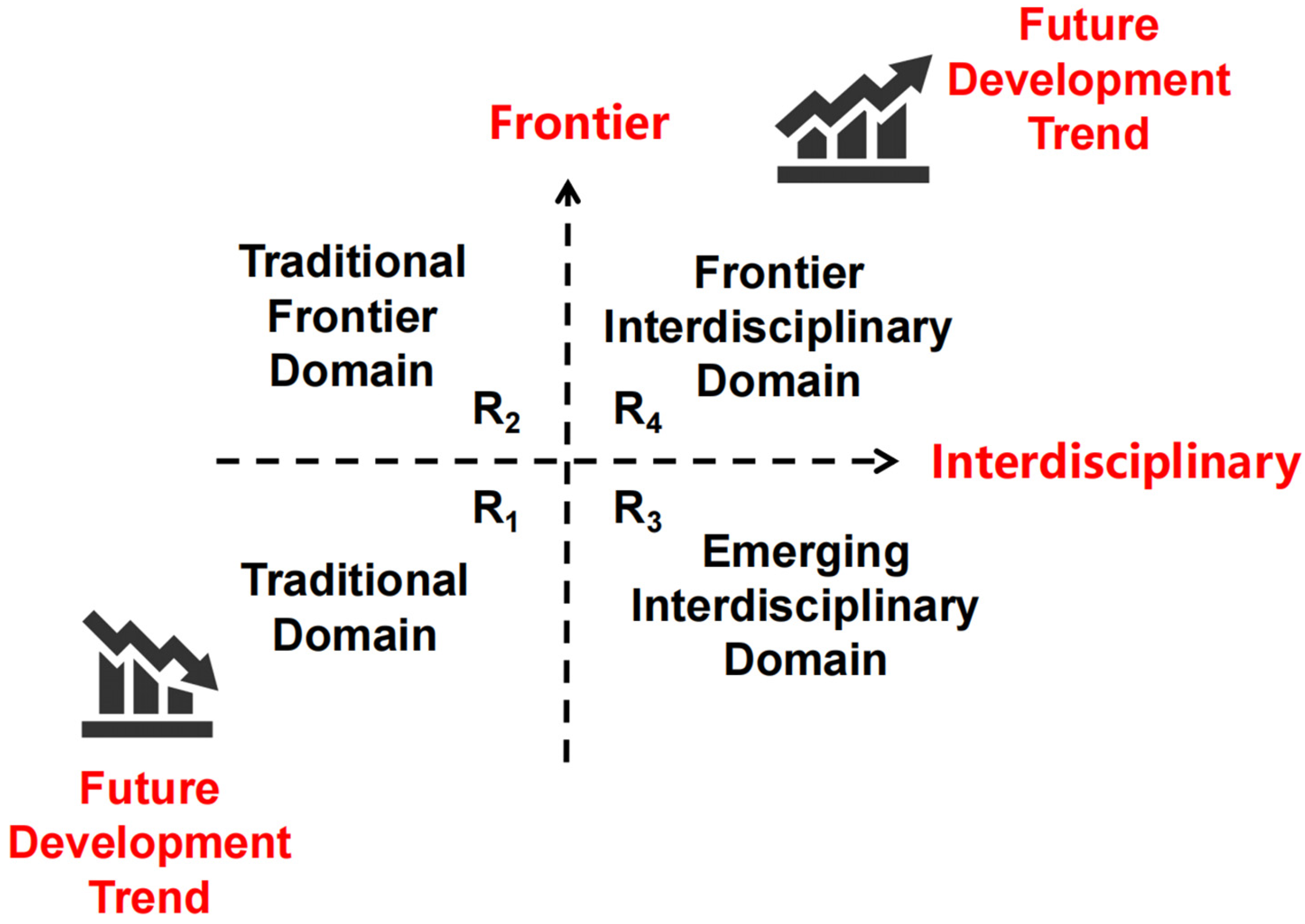
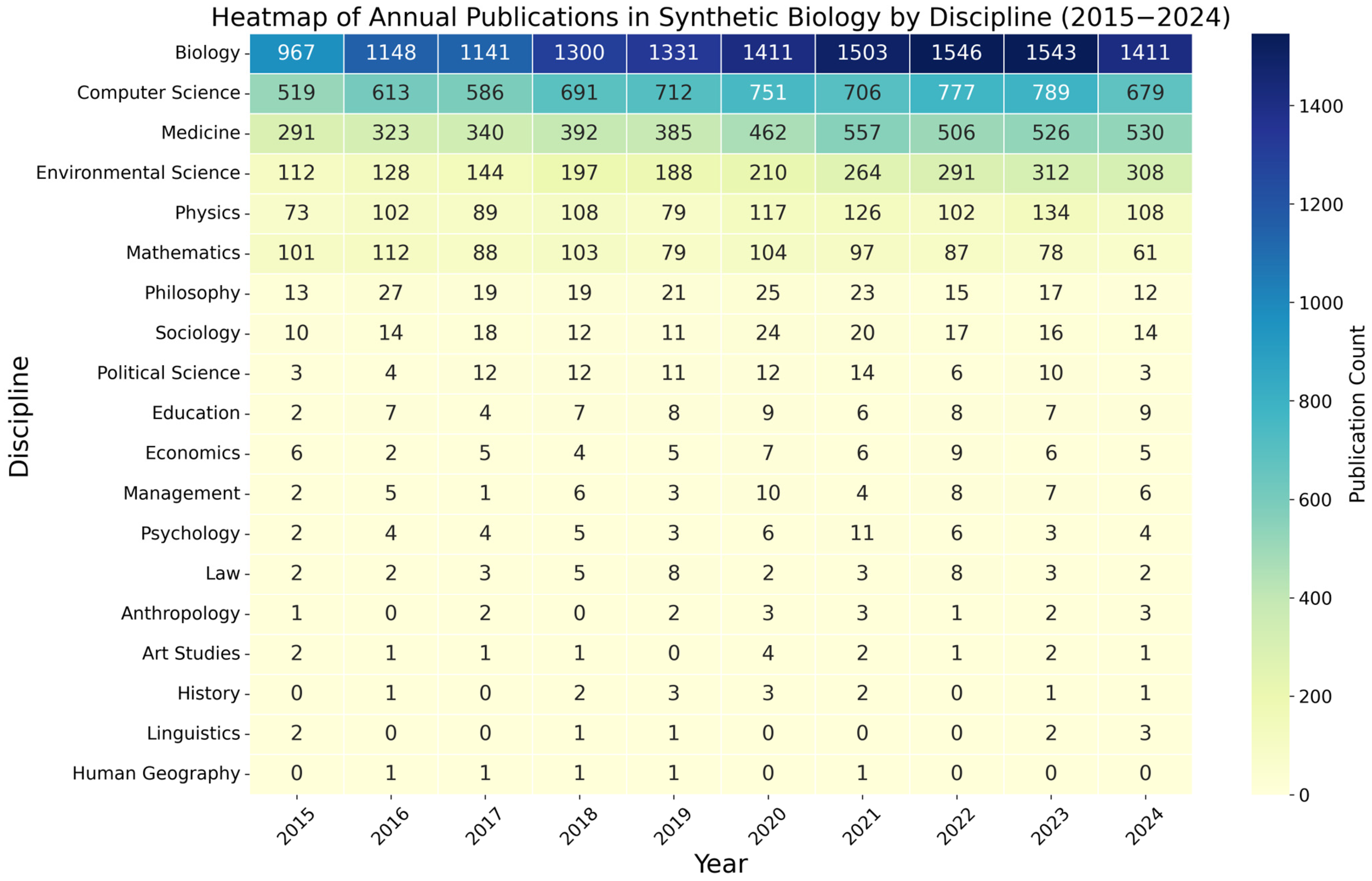
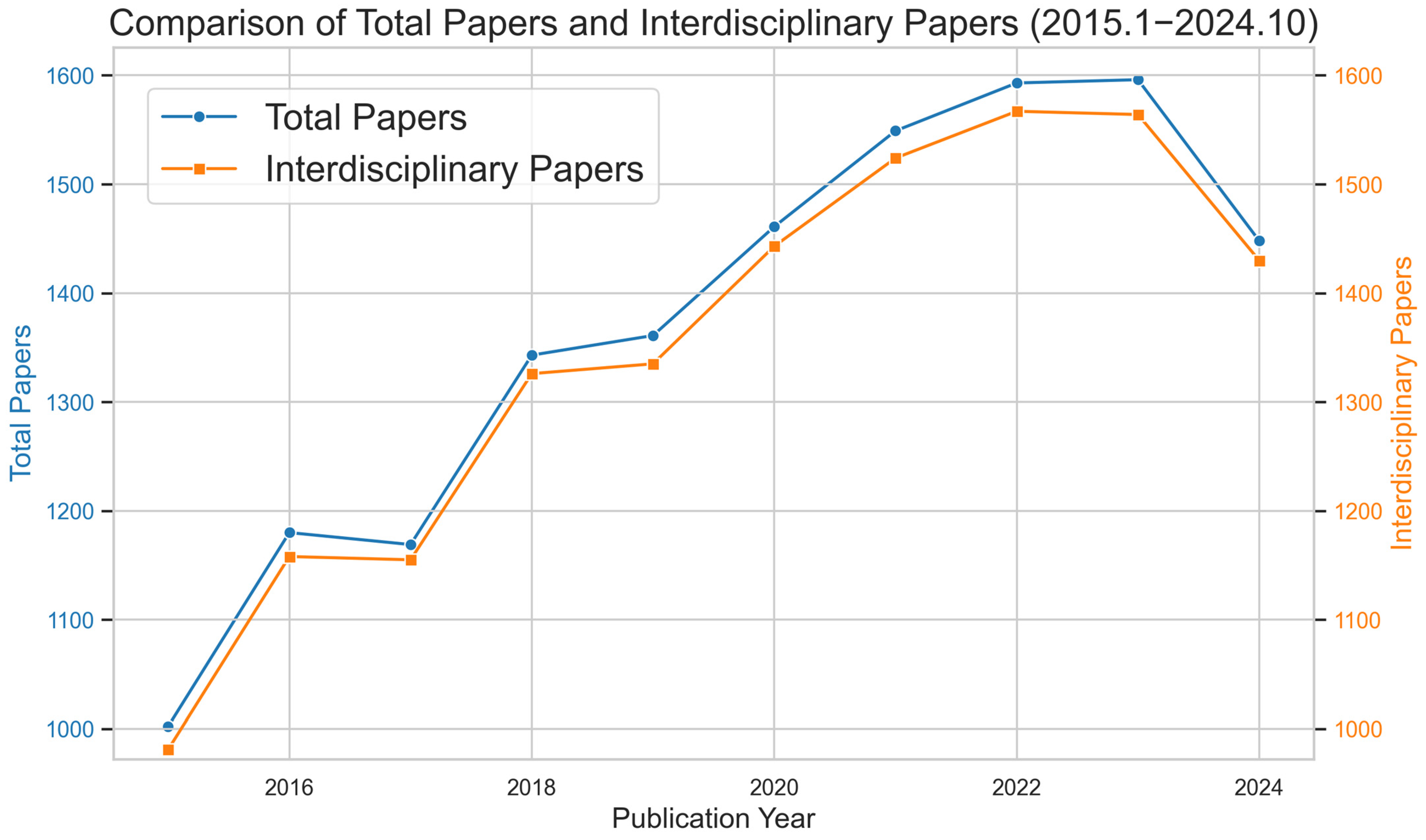
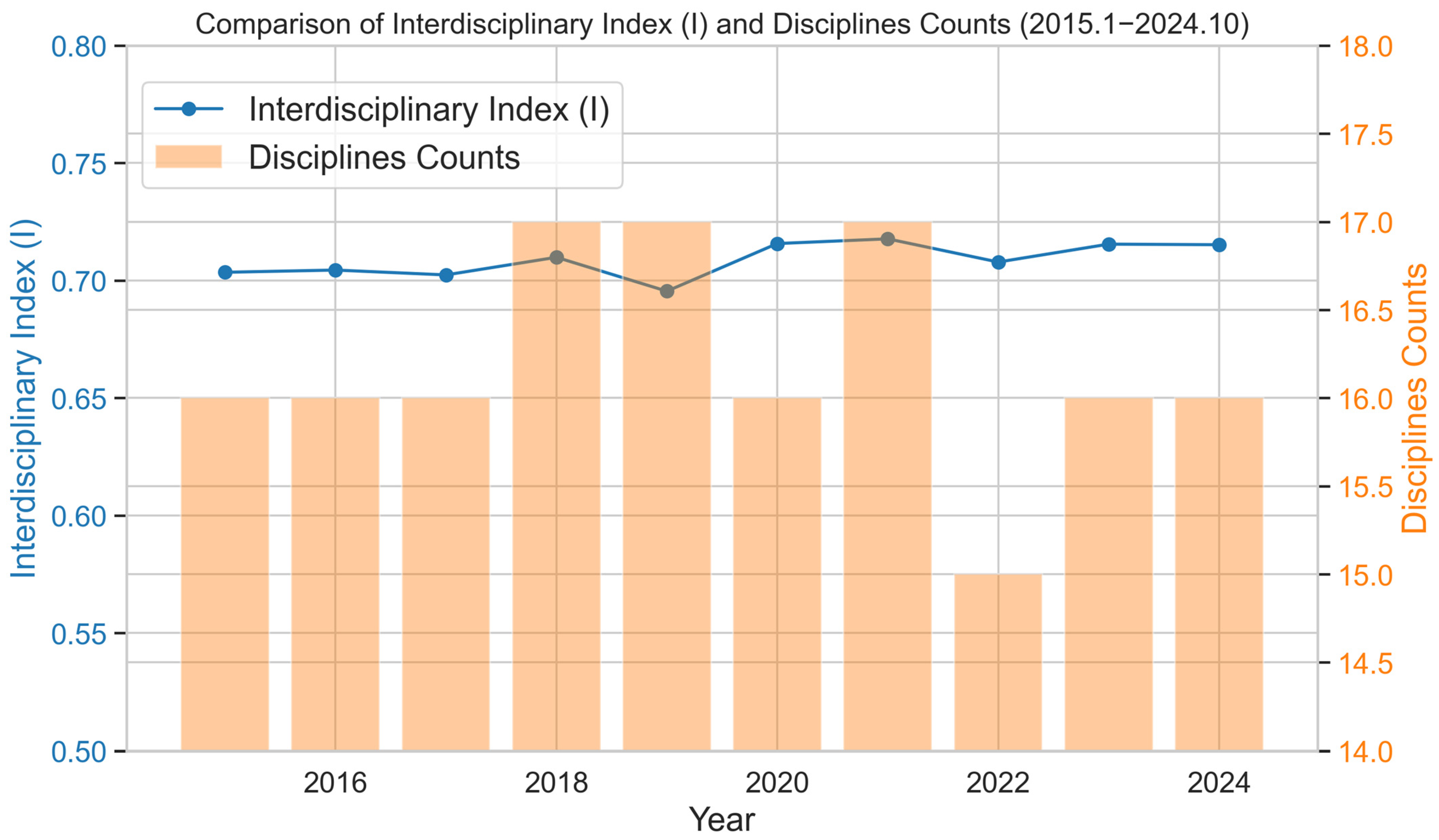
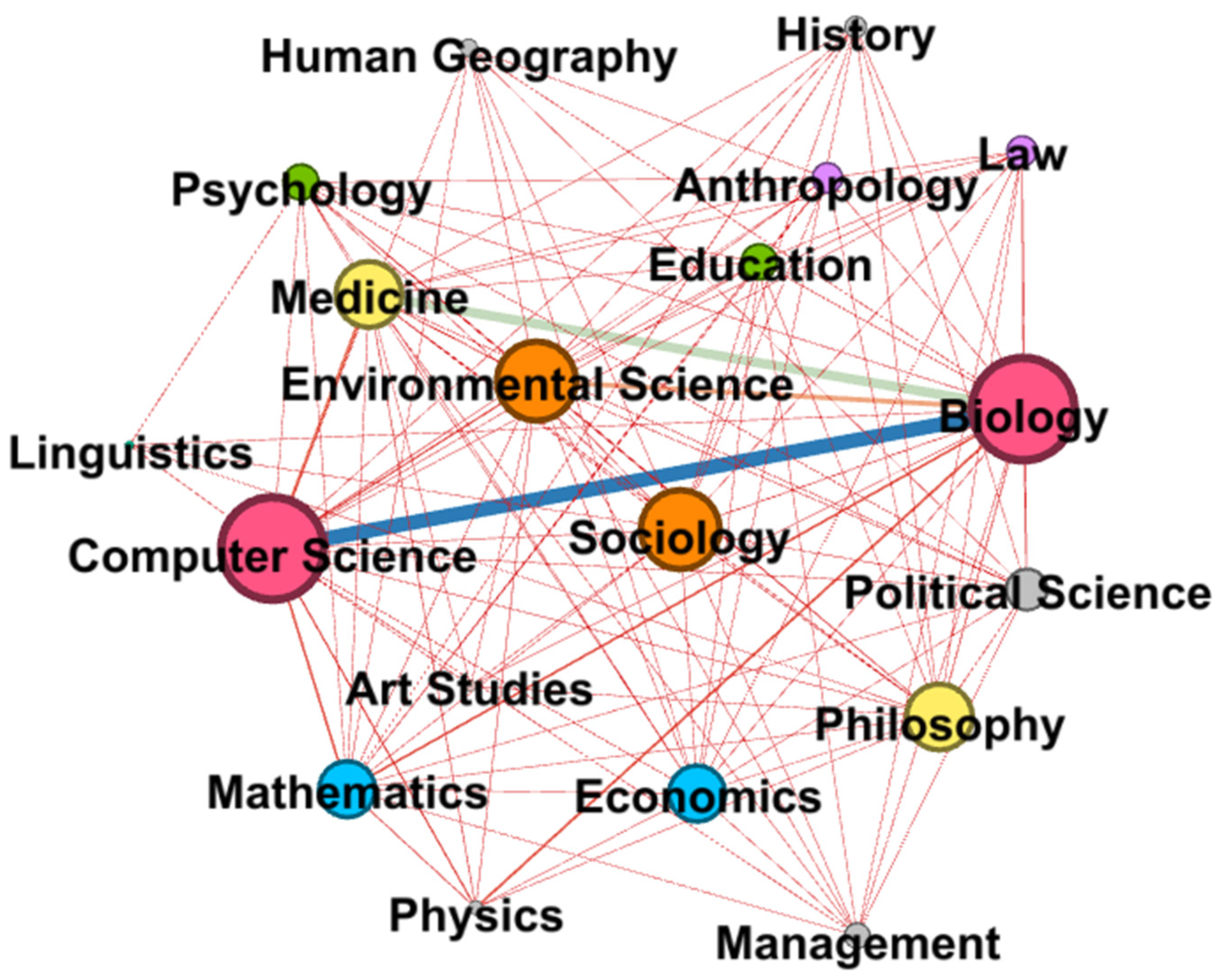

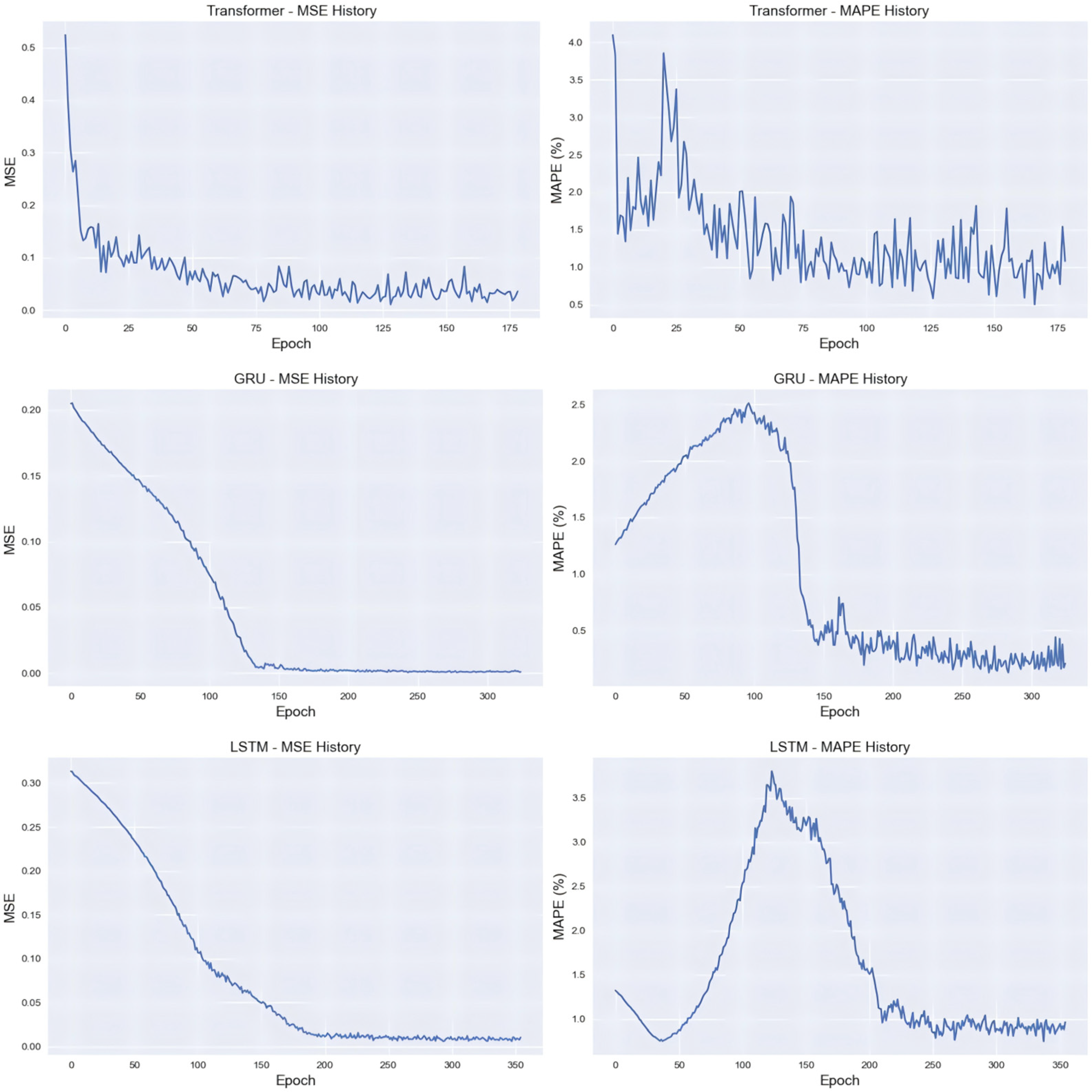

| Method | Advantages | Limitations |
|---|---|---|
| Citation Analysis | Reveals knowledge flow; quantifiable; useful for structural mapping | Time lag in citation accumulation; sensitive to self-citations |
| Keyword/Content Mining | Captures semantic patterns; scalable; identifies emerging terms | Dependent on keyword quality; limited semantic depth; difficulty with synonyms |
| Topic Modeling (e.g., LDA, BERTopic) | Detects thematic structure; supports trend analysis | Struggles with dynamic evolution; interpretability challenges; topic count sensitivity |
| Expert Judgment | Leverages domain knowledge; useful for early-stage fields | Subjective bias; lacks scalability; low reproducibility |
| Primary Indicator | Secondary Indicator | Indicator Type | Calculation Method |
|---|---|---|---|
| Temporal Integration Strength | Disciplinary Cohesion | Network Density | Measures the overall connectivity tightness |
| Interdisciplinary Connectivity | Average Degree | Describes the average number of connections per discipline |
| Research Area | Novelty Score |
|---|---|
| Synthetic Biology | 2019.860 |
| Information Technology and Services | 2006.220 |
| Algorithm Optimization | 2011.191 |
| Medical Data Modeling | 2021.260 |
| Machine Learning and Deep Learning | 2021.219 |
| Model | MAE | MSE | RMSE | MAPE/% | R2 |
|---|---|---|---|---|---|
| LSTM | 0.21 | 0.09 | 0.30 | 1.52 | 0.23 |
| GRU | 0.35 | 0.19 | 0.43 | 2.42 | 0.00 |
| Transformer | 0.06 | 0.00 | 0.07 | 0.22 | 0.96 |
| Random Forest | 0.58 | 0.45 | 0.67 | 8.85 | 0.00 |
| Linear Regression | 0.62 | 0.47 | 0.69 | 8.57 | 0.00 |
Disclaimer/Publisher’s Note: The statements, opinions and data contained in all publications are solely those of the individual author(s) and contributor(s) and not of MDPI and/or the editor(s). MDPI and/or the editor(s) disclaim responsibility for any injury to people or property resulting from any ideas, methods, instructions or products referred to in the content. |
© 2025 by the authors. Licensee MDPI, Basel, Switzerland. This article is an open access article distributed under the terms and conditions of the Creative Commons Attribution (CC BY) license (https://creativecommons.org/licenses/by/4.0/).
Share and Cite
Wu, Y.; Lin, Q.; Wu, J.; Yao, R.; Zhang, X. Identification and Prediction Methods for Frontier Interdisciplinary Fields Integrating Large Language Models. Systems 2025, 13, 677. https://doi.org/10.3390/systems13080677
Wu Y, Lin Q, Wu J, Yao R, Zhang X. Identification and Prediction Methods for Frontier Interdisciplinary Fields Integrating Large Language Models. Systems. 2025; 13(8):677. https://doi.org/10.3390/systems13080677
Chicago/Turabian StyleWu, Yu, Qiao Lin, Jinming Wu, Ru Yao, and Xuefu Zhang. 2025. "Identification and Prediction Methods for Frontier Interdisciplinary Fields Integrating Large Language Models" Systems 13, no. 8: 677. https://doi.org/10.3390/systems13080677
APA StyleWu, Y., Lin, Q., Wu, J., Yao, R., & Zhang, X. (2025). Identification and Prediction Methods for Frontier Interdisciplinary Fields Integrating Large Language Models. Systems, 13(8), 677. https://doi.org/10.3390/systems13080677






